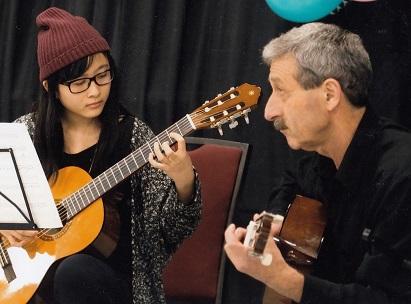
There are so many guitar playing styles to choose from that it can be tough to know where to start. There are also specific techniques associated with each playing style which weI will explain in the post below. Some are easy, some are difficult and some are in between. Here are some links to examples of different styles.
Common Guitar Styles
Blues
Blues feature a melancholic, sharp and slow music (generally sad). It follows a call-and-response format. It can be easy for beginners because of its simple chord progression. The focus is mainly on the guitarist/vocalist and is played on electric guitar.
Bluegrass
This music has American roots. Generally played with a fast tempo.
It is mostly acoustic and every instrument gets its turn to improvise around it, a resonating guitar is used to play the walking bass line. Bluegrass is a happy spirited music.
Carribean
This music style originated in Africa. It has evolved into many sub genres such as salsa, reggae, calypso, etc. A lot of percussion is involved. You can practise with backing tracks. The music gives a feel of the islands. Can be played on both electric and acoustic guitar.
Emo
Emo is a sub type of rock, just more emotional. It also has a diverse range. It includes bass and electric guitar.
The lyrics are a confessional type and it is generally sad.
Fingerstyle
It is an interesting style in which the player plays the melody and and the riff of the song with the bass line simultaneously. Plectrum is used not used in this style. It can be merged with the percussive style on acoustic instruments. Generally the player performs a solo. Can be played on any type of guitar.
Flamenco
Flamenco has Spanish roots and is an aggressive music style. It has a fast rhythm and picking pattern accompanied by percussive hits to provide the groove to the dancer. It can be both upbeat or downbeat but is always fast and dynamic.
Played on a flamenco guitar.
Folk
As the name suggests this style about people singing folk songs or the story of common people. One doesn’t needs to be professional player to sing or play folk. Played on folk guitar.
Jazz
Jazz is an independent art form, characterized by swing and blue notes, polyrhythms and improvisation. Most jazz is purely instrumental. It can be characterized as swinging, swaying and generally associated with smoothness but can be abstract and hyper. It has democratic improvisation, instrumental voicing, syncopated rhythms and complicated chord structures. Played on a jazz guitar.
Lead
Lead guitar has its part in every song and can be played on any type of guitar. Many song have lead improvisation sections. Guitarist uses many techniques to improvise a solo such as bend, slide, hammer ons, etc.
Percussive
Percussive guitar is style which requires lot of practise to master. The player hits the body of the guitar with the palm, finger edge or the nails. Hits on different part of the guitar body produce percussive sounds of different frequencies. The bass and snare drum can be mimicked to a certain degree.
Played on acoustic, classical or flamenco guitar.
Rhythm
Rhythm guitarist provides the driving force to a song. The rhythm guitarist unites the various other instruments and the vocalist with the beat. Rhythm guitar can be enough to provide company to the singer beside the campfire. Can be played on any type of guitar.
Rock
Rock is a style originated in the Unites States in the 50s and now has developed in a wide range of styles. It is influenced by blues, rhythm and blues and country music. Rock music, however, can’t be defined properly apart from its characteristic 4/4 beat. Mainly played on electric guitar.
Ska
Ska is known for its upbeat and groovy music. It is mainly played on acoustic guitar and is a combination of jazz, mento and rhythm and blues style.
It can be characterized by its walking bass line and rhythm on the off beat.
Slide
Lastly, slide guitar is a style in which instead of changing the pitch normally, it is change with a instrument called slide. The pitch change is smooth. The slide is moved on the frets without lifting for creating smooth transitions. Mainly played on acoustic guitar.
These all are just a brief characteristics. Music is still evolving as you read this. The lines which separate the various guitar styles are blurred.
One thing is clear, you will never run out of things to learn and how much ever you learn, it’s never enough.